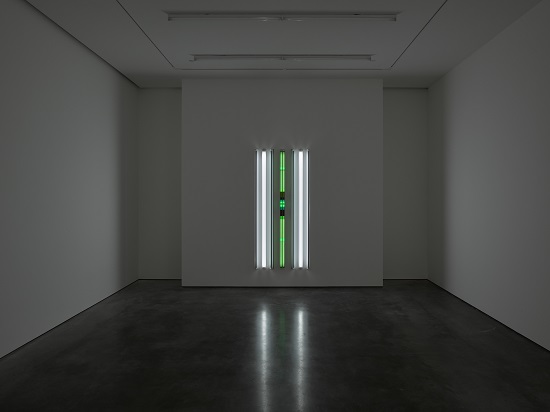Robert Irwin was recently asked by a friend if he fancied going to a conference in Chicago. The topic of this symposium was ecology. Irwin demurred, citing a prior commitment.
“What?” asked the friend incredulously. “You’re not interested in ecology?”
“What the fuck do you think I’ve been doing all my life?” he replied.
The 87-year-old American installation artist is holding court before the assembled staff of the White Cube gallery in south London. A gaggle of young interns and assistants hang on his words as he veers haphazardly away from whatever questions are being posed into a ramble of anecdotes and free associations.
Dressed casually in blue jeans and a baseball cap, Irwin speaks in the soft so-cal tones of someone who long ago came to his own personal understanding with the ocean. Born in Long Beach, California, in 1928, Irwin began his career as a painter, besotted by the unbridled gestures of abstract expressionists like Franz Kline and especially Willem de Kooning. But at a time when all the big painters were doing bigger and bigger canvases, Irwin began to make his paintings smaller and smaller, their content ever more minimal, paring his brushstrokes down to an essential minimum.
Over the succeeding years he would call into question and ultimately suspend almost all the elements of a traditional artwork: first the painterly gesture itself, then the distinction between figure and ground, even the frame and its edges as he began to exhibit convex discs that seemed to melt into the walls they were suspended from. Finally he stopped exhibiting objects altogether.

In 2009 the Pompidou Centre in Paris held a retrospective entitled Voids. The show consisted of nine empty white-walled rooms, each one presented as a re-staging of a different historically significant exhibition at which nothing at all was exhibited.
Yves Klein’s (1958) The Specialization Of Sensibility In The Raw Material State Into Stabilized Pictorial Sensibility had simply emptied out the Iris Clert Gallery, locked the doors and left the lights on inside. Art & Language’s Air Conditioning Show, no more than white walls and a lengthy bit of text, sought to put into question the status of the art object and its institutional status. Nearly half a century later, Roman Ondák’s More Silent Than Ever consisted – or so it claimed – of no more than a concealed listening device.
But Robert Irwin’s Experimental Situation, first presented at the ACE Gallery, Beverley Hills, in 1970 (and also included in the Pompidou show) was a consequence less of the mystical concerns of Yves Klein, the intellectual concerns of Art & Language, nor the political interests of Roman Ondák. Here was something far more practical.
As he explained to the assembled staff at the White Cube, he had at that time been spending increasing amounts of time in the desert at what is called the Four Corners – that is, the junction between Utah, Arizona, New Mexico and Colorado. “What is nice about it,” Irwin said of this arid patch between Monument Valley and the Mesa Verde, “is that it’s not made up of objects. It’s made of ambiances.” In this strange in-between place, this windswept no-place, Irwin began to contemplate “the idea of not making things.”
While those works of Irwin’s currently on show at the White Cube are far from non-existent, there remains at least something curiously insubstantial about them. Two clear plastic pillars, both Untitled (Acrylic Column), inhabit the room less as something to look at, more something to look through. The delicately defined curves shift the way they accent their surroundings depending on the viewer’s perspective – one moment almost invisible, the next showering prismatic colours from any edges that happen to be caught in their glare. Each one, Irwin claims, was fashioned with the precision of a contact lens.
Facing these, over in the North Galleries, hangs a work that does not so much inflect the room as double it. Black Painting consists of a diptych of sable monochromes, each one 60 inches in length and height. Despite the clear reference, however, the actual sensation of looking at this work is very different to the brutal slap in the face of Kasimir Malevich’s Black Square of a century ago. Irwin has taken honeycomb aluminium panels, coated them with polyurethane paint and lacquered them until they gleam. They reflect not nothing, but everything – welcoming the whole room into their frames.
Irwin first began working directly with fluorescent lights in 1970. He was invited to transform a room at New York’s Museum Of Modern Art but given no budget and no real support. So he changed the bulbs in the strip lights and hung up a scrim to divide the room in two, creating a subtle rainbow effect in the room, half vague and diffuse and half razor precise. The four new light works included here are, he insists, to be his last.
Of course, Irwin is far from alone. Many artists in the sixties and seventies began to seek in strip lighting that “new palette” that Irwin praises. But again, it’s the difference in approach that sets him apart. His light works seem less like something to look at, more a means of altering the whole space that the viewer inhabits.
“Light,” he says, presents “a palette that’s different from any other palette because it emits light and refracts light.” Nothing ever exists in isolation. These works are inevitably as much about the interaction between the different sets of lights – and between the lights, the viewer, and the whole situation.
“What makes an artist,” Irwin claims, “is that unique sensibility.” It is less about the quality of the works themselves, more the relationship between the artist and his works and the world around them. Ecology, effectively. For Robert Irwin this is always about something physical, tactile, perceptual: “this kind” he says, rubbing his fingers together, “of understanding of the world.”


